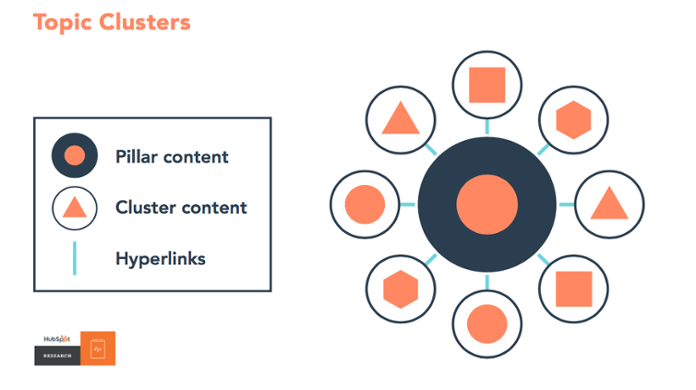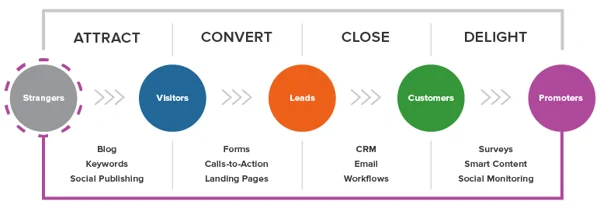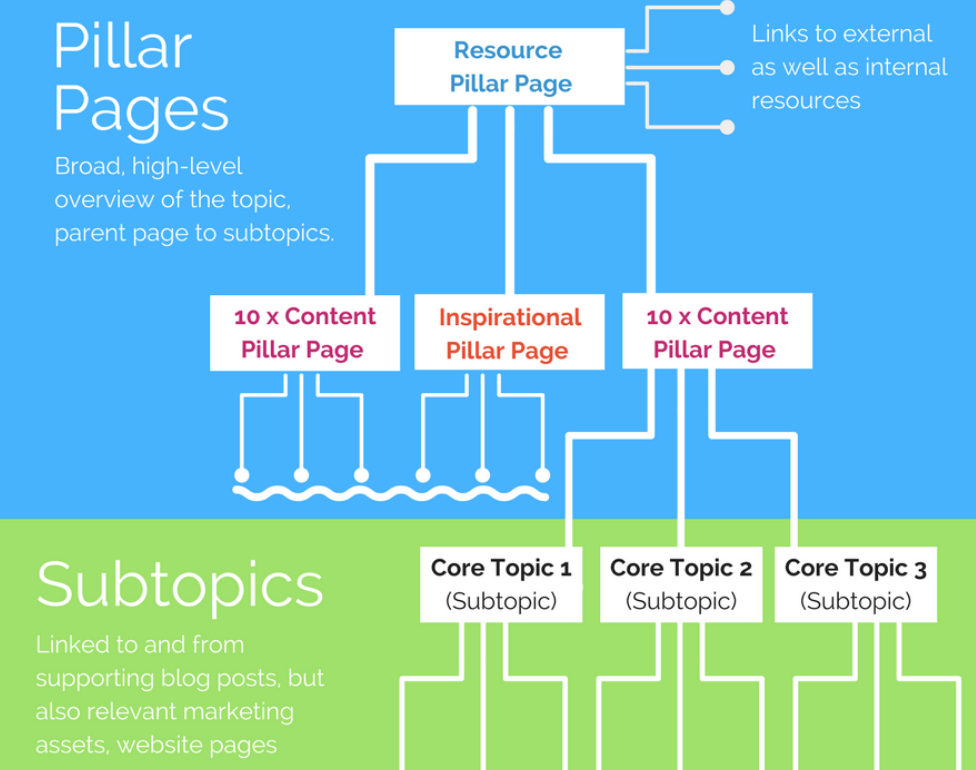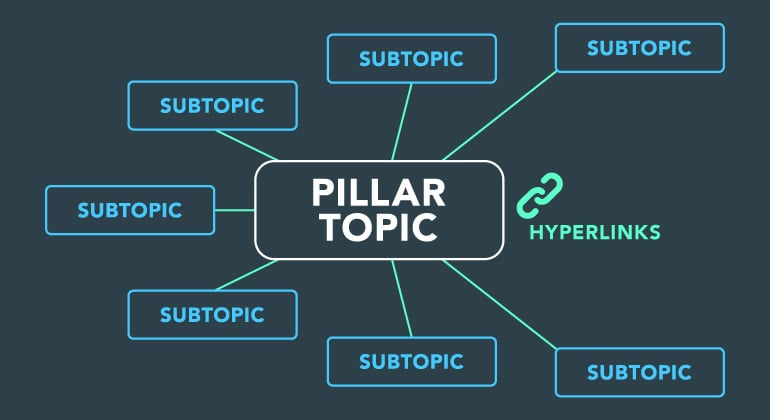A concept that has gained significant traction in recent years is the use of topic clusters.
This innovative SEO Content Strategy can significantly enhance your content organization for SEO success, providing a structured and user-friendly way to boost your lead generation efforts and establish authority in your niche.
The article offers insight into how you can effectively improve your lead-generation efforts with topic clusters.
Table of Contents
- 1 – The Two Main Types of Clusters in Content Planning
- 2 How Topic Clusters Can Boost Lead Generation
- 3 How to Implement Topic Clusters for Lead Generation
- 3.1 1. Identify Your Target Audience:
- 3.2 2. Keyword Research and Clustering
- 3.3 3. Choose Pillar Topics:
- 3.4 4. Create Pillar Content:
- 3.5 5. Identify Subtopics:
- 3.6 6. Create Cluster Content:
- 3.7 7. Optimize for SEO:
- 3.8 8. Promote Your Content:
- 3.9 9. Lead Capture Mechanism:
- 3.10 10. Nurture Leads:
- 3.11 11. Analyze and Iterate:
- 4 Incorporating High-Value Opt-Ins for Effective Lead Generation
- 5 Activities That Don’t Help with Lead Generation
- 6 Conclusion
– The Two Main Types of Clusters in Content Planning
In the context of SEO content planning, there are two main types of clusters: topic clusters and keyword clusters.
Topic clusters are groups of interlinked content centered around a single, broad topic.
Keyword clusters, on the other hand, are groups of related keywords that a single piece of content aims to rank for.
Both types play a crucial role in a comprehensive SEO content strategy and are particularly effective for establishing topic authority.

At the heart of a topic cluster is the ‘pillar’ content—a comprehensive piece that covers a broad topic in depth.
It serves as the ‘hub’ of the topic cluster, linking out to all the cluster content.
Surrounding this pillar are ‘cluster’ contents—more specific, related pieces that link back to the pillar and each other.
Together, these components enhance the user experience and help search engines understand the semantic relationships between your content pieces, improving your visibility and rankings.
How Topic Clusters Can Boost Lead Generation
The primary purpose of a Topic cluster content strategy is to enhance your SEO performance, improve the user experience on your site, and establish your niche authoritativeness.
Ideally, this concept represents a paradigm shift in how we approach SEO and content marketing.
Instead of viewing each piece of content as an isolated entity, topic clusters consider the interconnectivity of content around a central theme.

For users, a topic authority map provides a guided and intuitive journey through your content, increasing engagement and retention.
By focusing your content around key topics of interest to your target audience, you can establish your authority on those topics, attracting more qualified leads who are likely to be interested in your products or services.
Additionally, they also allow business owners to track their results since they can monitor the performance of your content and see what is working well and what is not.
How to Implement Topic Clusters for Lead Generation

Here are seven steps to effectively use the topic cluster method for lead generation:
1. Identify Your Target Audience:
To successfully generate leads with topic clusters, you must start by understanding your audience.
Conduct thorough market research to create detailed buyer personas.
These personas should encompass demographics, pain points, goals, and preferences.
Knowing your audience intimately will also enable you to create content that resonates deeply with their needs.
2. Keyword Research and Clustering
Keyword research is the cornerstone of your topic cluster strategy.
Start by identifying a SEED keyword that is broad enough to cover multiple topics for a comprehensive keyword list.
With your keyword research results, group them by clustering them based on their semantic similarity and relevance.
This is what will help you strategize your topic clusters and plan the content you intend to produce.
For reference, make sure to review our previous article about effective keyword and topic clustering, which goes into length about this process.
3. Choose Pillar Topics:
You should strategically select pillar topics.
Consider topics that align with your business objectives, represent your expertise, and have the potential to attract a broad audience.
These topics should also be evergreen, as they will serve as the foundation for years of content.
4. Create Pillar Content:
Your pillar content should be a comprehensive resource that covers the topic in-depth.
Dive into the nuances, provide original insights, and support your claims with data and examples.
Remember, this is your opportunity to showcase your expertise and establish trust with your audience.

5. Identify Subtopics:
Subtopics should be specific angles or aspects of your pillar topic.
These can be easily identified from your keyword and topic clustering results.
You can also use brainstorming sessions, customer questions, and keyword research to identify subtopics that your audience is actively searching for.
As a general rule, these should be topics that naturally flow from your pillar content, providing more details about what you already mentioned there.
Consider reviewing our recent article about mastering topic clusters for reference.
6. Create Cluster Content:
When creating cluster content, focus on delivering actionable and digestible information.
These pieces should be concise yet informative and should link back to the pillar pages and other relevant pages within the cluster.
Use visuals, case studies, and real-world examples to engage your audience.
Remember that quality and relevance matter more than quantity.
7. Optimize for SEO:
Search Engine Optimization (SEO) is a critical aspect of your topic cluster strategy.
Proper SEO optimization ensures that your content is discoverable by search engines like Google, increasing the chances of attracting organic traffic and potential leads.
Beyond keywords, consider mobile-friendliness, page load speed, and schema markup.
8. Promote Your Content:
Content promotion is as important as creation.
Share your content on multiple platforms, including social media, industry forums, and relevant online communities.
From the very start, create a content promotion plan that outlines how, when, and where you’ll share your content.
9. Lead Capture Mechanism:
The lead capture process should be seamless and non-intrusive.
Strategically place lead capture forms or Call-to-Actions (CTAs) where they make sense within the content.
Consider implementing exit-intent pop-ups or gated content behind forms to capture leads at different touchpoints.
10. Nurture Leads:
Nurture your leads through personalized email sequences and marketing automation.
Segment your leads based on their behavior and interests.
Additionally, tailor your messages to provide additional value, answer questions, and gradually guide leads through the sales funnel.
11. Analyze and Iterate:
Regularly analyze your content’s performance using tools like Google Analytics and CRM systems.
Pay attention to metrics like click-through rates, conversion rates, and customer acquisition costs.
You can use A/B testing to refine your CTAs and lead capture forms.
Incorporating High-Value Opt-Ins for Effective Lead Generation
Each piece of content within your cluster presents a unique opportunity to attract new leads.
You can enhance the value proposition for your readers by offering them the chance to opt in to receive a complimentary resource, such as a white paper, checklist, or e-book.
This can go a long way to help you build a high-value email list and nurture leads into customers.
When choosing a complementary resource, it is important to make sure that it is relevant to your target audience and that it provides them with value.
You should also make sure that the opt-in form is easy to find and complete.
Implementing Content Gating and How It Helps Capture Leads
Content gating is a strategic approach where certain high-value content is made accessible only after a user has provided specific details, such as registering for an account or giving an email address.
This method can be a powerful tool for encouraging more leads to opt into your email list.
There are several ways you can implement content gating without compromising your SEO.
They include:
- Offer Teaser Content: Before gating, provide a preview or snippet of the content. This allows search engines to index some of the content and gives users a taste of its value, ensuring they know what they’re committing to.
- Prioritize Quality: The gated content should be top-notch. If users find the content underwhelming after signing up, it can lead to increased bounce rates, which can indirectly affect SEO.
- Optimize the Landing Page: Ensure the landing page for your gated content is SEO-friendly, with relevant keywords, a clear meta title, and a description. Even if the main content is behind a gate, the landing page can still attract organic traffic.
- Maintain a Balance: While gating high-value pieces is effective, ensure a significant portion of your content remains freely accessible. This ensures search engines have ample content to crawl and index.
- Leverage Schema Markup: Use schema markup for gated content to indicate its subscription or registration-based nature, helping search engines understand the content’s context.
- Regularly Review Your Strategy: Monitor the performance of your gated content. If there’s a decline in organic traffic or other SEO metrics, consider revising your approach.
Activities That Don’t Help with Lead Generation
Lead generation is a critical aspect of any successful business strategy.
However, not all activities contribute positively to this process.
In fact, some can be counterproductive and a waste of time and resources:
- Irrelevant Content Creation:
Creating content that doesn’t align with your target audience’s interests or needs is a waste of resources.
Content should always be designed to provide value and engage potential leads.
- Overemphasis on Vanity Metrics:
Focusing solely on vanity metrics like page views or social media likes without considering conversion rates and lead generation can lead to a false sense of success.
These metrics may not reflect the true impact of your content.
- Keyword Stuffing:
Stuffing your content with keywords unnaturally can hurt your SEO efforts and make your content less appealing to readers.
Prioritize providing valuable information over keyword density.
- Ignoring User Experience (UX):
A poor website or content layout can deter potential leads.
Ensure that your website is user-friendly, mobile-responsive, and easy to navigate to create a positive user experience.
- Neglecting Quality for Quantity:
Producing an excessive amount of low-quality content can dilute your brand’s authority and may not engage your audience effectively.
Instead, focus on creating high-quality, informative content that resonates with your audience.
- Failure to Update Content:
Neglecting to update and refresh your content can lead to outdated information, diminishing its value.
Ensure you regularly revisit and update your content to maintain its relevance.
- Ignoring Audience Engagement:
Content should encourage engagement, such as comments, shares, and discussions.
Neglecting these interactions can miss opportunities to connect with potential leads.
- Not Utilizing Analytics:
Failing to analyze the performance of your content can hinder your ability to refine your strategy.
Use analytics tools to track user behavior, conversion rates, and other relevant metrics to make data-driven decisions.
- Neglecting Content Promotion:
Even the most valuable content won’t generate leads if it’s not properly promoted.
As such, share your content through various channels and engage with your audience to maximize its reach.
- Ignoring SEO Best Practices:
Ignoring fundamental SEO practices, such as optimizing meta descriptions, using relevant headers, and improving page load speed, can hinder your content’s discoverability.
- Lack of Personalization:
Failing to personalize content or communication with leads can result in missed opportunities.
Tailor your content and messaging to address the specific needs and pain points of different segments of your audience.
Conclusion
To sum up, topic clusters represent a powerful tool in the arsenal of any digital marketer. By providing a structured and user-friendly way to organize and present content, they can significantly enhance your SEO performance and lead generation efforts. Whether you’re a seasoned SEO expert or just starting out, implementing a topic cluster strategy can help you stay ahead of the competitors.



